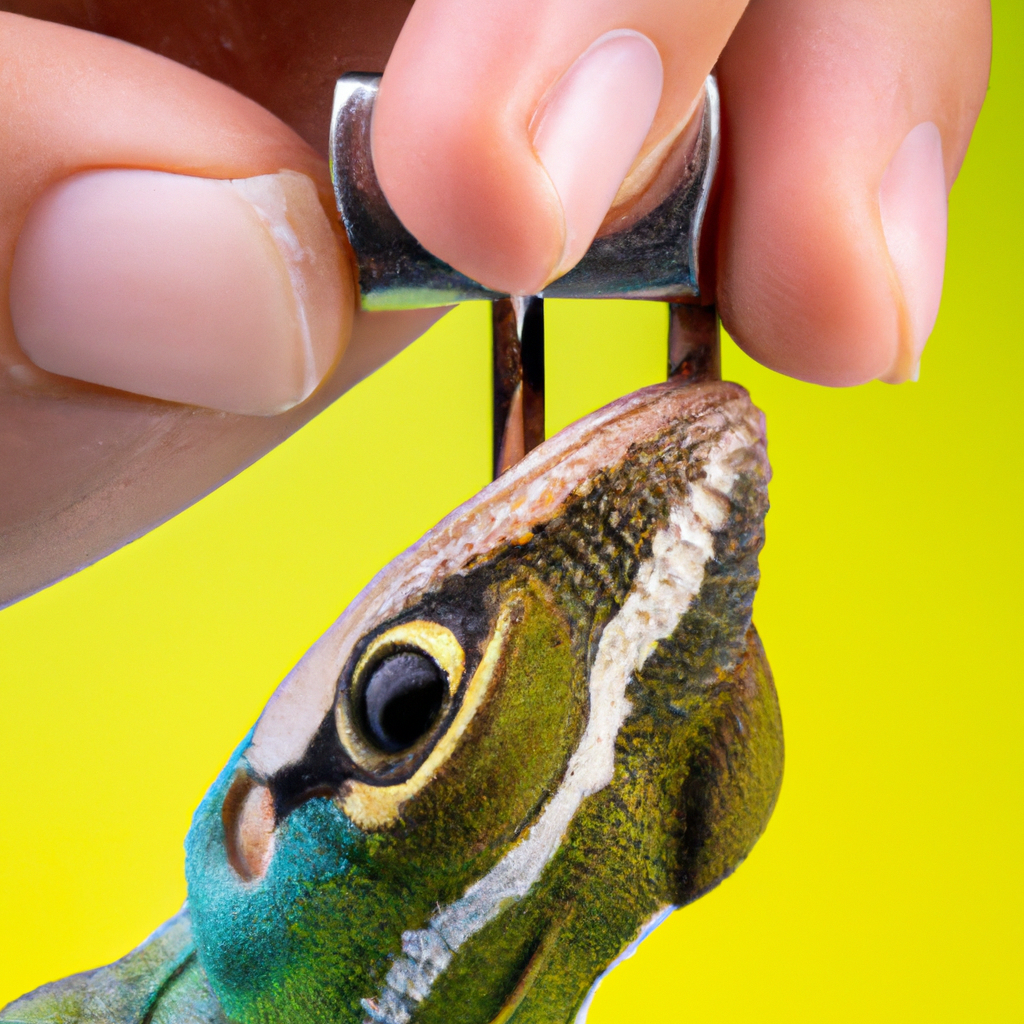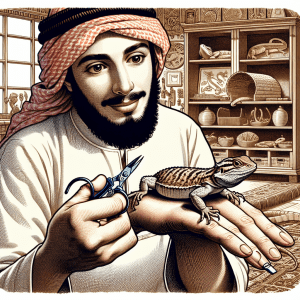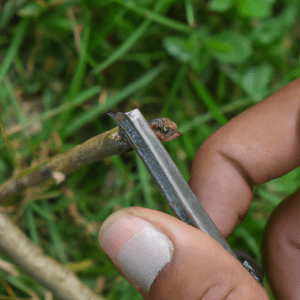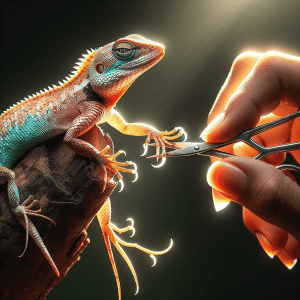Importance of Nail Trimming for Pet Lizards
Have you ever noticed how some pet lizards have those impressively sharp nails? Well, today we’re diving into the world of nail trimming for our scaly friends. It may sound like a trivial task, but trust me, it’s essential for their health and comfort.
Lizards, just like us, need proper nail care. Imagine going for a walk with your lizard buddy, and those long nails accidentally scratching you—ouch! That’s why understanding the anatomy of lizard nails is crucial. These nails serve various functions, from climbing to defense, so we must trim them carefully.
Now, here’s an interesting fact for you: Did you know that some lizards shed their entire nail sheath periodically? It’s a natural process, but sometimes they may need a little help. That’s where we come in! By using the right tools, such as specialized clippers or files, we can ensure a safe and efficient nail trimming session for our scaly companions.
As we embark on the nail trimming journey, remember to approach it with patience and care. Picture yourself gently holding your lizard’s paw—okay, maybe not exactly like that, but you get the idea. Following a step-by-step guide will help you navigate this task smoothly and, most importantly, ensure your lizard’s well-being.
Now, here’s a practical tip: before you start trimming, make sure to have some styptic powder on hand, just in case of any accidental nicks. It helps stop bleeding quickly and keeps your lizard comfortable throughout the process.
As you delve into the art of nail trimming for pet lizards, think about the bond you share with your scaly friend. It’s a moment of care and trust, strengthening your connection and ensuring their health. So, grab those clippers, take a deep breath, and let’s give those nails a trim they won’t forget!
Understanding the Anatomy of Lizard Nails
Understanding the Anatomy of Lizard Nails is crucial when it comes to ensuring the well-being of our scaly friends. Have you ever noticed how sharp and sturdy lizard nails can be? It’s like they come equipped with built-in tools for climbing and digging!
Did you know that the structure of a lizard’s nail is quite different from that of a mammal’s claw? Lizard nails are composed of keratin, the same protein that forms human hair and nails. This makes them tough and resilient, perfect for their natural behaviors in the wild.
Imagine this – a lizard’s nails are not just for show; they play a vital role in their daily activities. From grasping onto branches to hunting for prey, those nails are essential tools for survival. It’s fascinating how nature equips each creature with unique features tailored to their specific needs.
Understanding the anatomy of lizard nails can help us appreciate the complexity of these incredible reptiles. Next time you observe your pet lizard climbing or exploring its habitat, take a moment to admire the functionality and purpose behind those seemingly simple nails. By gaining insight into their anatomy, we can better care for our pet lizards and ensure they lead healthy and enriched lives.
So, the next time you’re trimming your lizard’s nails, remember that each snip is not just about grooming – it’s a way to support their natural behaviors and keep them comfortable in their environment. Let’s dive deeper into the world of lizard nails and explore how we can best care for our scaly companions.
Tools Required for Safe Nail Trimming
When it comes to trimming your pet lizard’s nails, having the right tools is key. I remember the first time I attempted to trim my lizard’s nails without the proper equipment—it was quite a challenge! So, let me share some insights on the tools required for safe and effective nail trimming.
One essential tool you’ll need is a good pair of reptile nail clippers. These clippers are designed specifically for the delicate nails of lizards, ensuring a clean cut without causing any harm. They usually have a small size and a precise cutting edge, making the task much easier.
Another useful tool is a styptic powder or gel. Accidents can happen, and if you accidentally cut too close to the quick (the blood vessel inside the nail), the styptic powder can help stop the bleeding quickly. It’s a handy item to have in your lizard’s nail trimming kit.
Additionally, having a small towel or cloth on hand can be beneficial. This will allow you to gently wrap your lizard to help keep them calm and secure during the nail trimming process. It can also help prevent any sudden movements that could lead to an accidental cut.
Lastly, a bright light source such as a small flashlight can be extremely helpful. This will help you see the nails more clearly, especially if your lizard has dark-colored nails. Proper lighting is essential to ensure you trim the nails accurately without causing any harm.
By having these essential tools ready, you’ll be well-equipped to trim your pet lizard’s nails safely and efficiently. Remember, patience and a steady hand are equally important when it comes to nail trimming. With the right tools and technique, you can make this grooming task a stress-free experience for both you and your lizard.
Step-by-Step Guide to Trimming Your Lizard’s Nails
Have you ever tried trimming your pet lizard’s nails? It can be a bit tricky, but with the right tools and technique, it’s totally doable! Let me walk you through a step-by-step guide on how to trim your lizard’s nails without any stress or hassle.
First things first, before you even think about trimming those nails, it’s important to gather all the necessary tools. You’ll need a pair of small, sharp nail clippers specifically designed for reptiles. Trust me, using the right tools will make the process much smoother and safer for both you and your lizard.
Now, let’s get into the actual nail trimming process. Start by gently restraining your lizard, being careful not to cause any stress or harm. You can wrap your lizard in a soft towel to help keep them calm and secure during the procedure. Once your lizard is comfortable, take a close look at their nails. Identify the quick – the pink part inside the nail that contains blood vessels and nerves. You want to avoid cutting into the quick, as it can be painful and cause bleeding.
When you’re ready to trim, make small, precise cuts to remove the tip of the nail. It’s better to trim a little at a time than to cut too much off at once. Remember, patience is key! If your lizard seems agitated or uncomfortable, take a break and try again later.
As you go through the process, keep an eye out for any signs of distress from your lizard. If they start to show signs of discomfort, stop immediately and give them a break. It’s essential to prioritize your lizard’s well-being throughout the nail trimming process.
By following these simple steps and taking your time, you can successfully trim your pet lizard’s nails without any fuss. Remember, practice makes perfect, so don’t worry if you’re a bit nervous at first. With a little practice and patience, you’ll become a pro at nail trimming in no time!
Tips for Ensuring a Stress-Free Nail Trimming Experience
Have you ever tried to trim your pet lizard’s nails and ended up with a little more chaos than expected? Trust me, I’ve been there! Nail trimming can be quite a task, but fear not, I’ve got some tips to make the process smoother for both you and your scaly friend.
To ensure a stress-free nail trimming experience, one practical tip is to make sure you have all the necessary tools handy before you begin. Having the right tools not only makes the process easier but also safer for your pet lizard. A pair of nail clippers specifically designed for reptiles is essential. Avoid using regular clippers meant for humans as they can crush or splinter the nail, causing discomfort to your lizard.
Another important tip is to have some styptic powder on hand. This powder helps to stop bleeding in case you accidentally trim the nail too short and hit the quick. It’s a good idea to have this on standby as a precautionary measure.
Additionally, to keep your lizard calm during the nail trimming session, try to create a comfortable and familiar environment. Choose a quiet and well-lit area where your lizard feels at ease. You can also soothe your pet with gentle words and slow movements to help minimize any stress or anxiety.
Remember, it’s crucial to trim your lizard’s nails regularly to prevent them from becoming too long and causing discomfort or potential injury. By following these tips and approaching nail trimming with patience and care, you can make the process a breeze for both you and your beloved pet lizard.
Common Mistakes to Avoid When Trimming Lizard Nails
Have you ever tried trimming your pet lizard’s nails? It can be a bit daunting, but with the right approach, you can make it a stress-free experience for both you and your scaly friend. Let me tell you about some common mistakes to avoid when trimming lizard nails.
First off, one common mistake is using the wrong tools. Trust me; you don’t want to use regular nail clippers meant for humans. Lizard nails are delicate and require special tools designed for them. Using the wrong tools can lead to injuries and discomfort for your pet.
Another mistake many lizard owners make is trimming the nails too short. It’s essential to only trim the tip of the nail and avoid cutting into the quick, which can cause bleeding and pain for your pet. Remember, it’s always better to trim less than to risk cutting too much.
Timing is crucial when it comes to nail trimming. If your lizard is stressed or agitated, it’s best to postpone the trimming session. A calm and relaxed lizard will make the process much more manageable. Consider creating a comfortable and familiar environment for your pet before starting the nail trimming procedure.
One more mistake to avoid is neglecting regular nail maintenance. Just like us, lizards’ nails continue to grow, and without proper trimming, they can become too long and cause discomfort or even health issues. Make nail trimming a routine part of your lizard care to keep their nails in top condition.
By being aware of these common mistakes and taking the necessary precautions, you can ensure a safe and successful nail trimming session for your pet lizard. Remember, patience and gentle handling are key to making the experience pleasant for both you and your scaly companion.
Alternatives to DIY Nail Trimming: Seeking Professional Help
Have you ever considered seeking professional help for trimming your pet lizard’s nails? I know, it sounds fancy, right? But let me share a personal anecdote that might change your mind. My friend, Sarah, thought she was a pro at trimming her lizard’s nails until one day she accidentally cut too close and caused bleeding. It was a chaotic scene with her lizard squirming around, and despite her best efforts to stop the bleeding, it was a stressful situation for both Sarah and her pet.
Thinking about Sarah’s experience, it’s essential to understand that seeking professional help for nail trimming isn’t just about convenience—it’s also about ensuring the safety and well-being of your pet lizard. Professional reptile groomers or veterinarians have the expertise and experience to handle the task with precision and care, minimizing the risk of accidents and ensuring a stress-free experience for both you and your lizard.
So, the next time you consider trimming your pet lizard’s nails, think about the benefits of opting for professional assistance. It’s not just about avoiding mishaps; it’s also about providing the best care possible for your scaly friend. After all, when it comes to your pet’s health and happiness, a little expert help can go a long way.
Remember, your pet lizard relies on you to keep them safe and healthy, so why not give them the VIP treatment they deserve? Consider the option of seeking professional help for nail trimming, and you’ll be taking a proactive step towards ensuring your lizard’s well-being.
Keeping Your Pet Lizard Healthy with Proper Nail Care
Have you ever wondered about the alternative options available when it comes to trimming your pet lizard’s nails? It’s a topic that often sparks curiosity among reptile owners looking for the best care for their scaly friends. Let me share some insights with you on this interesting aspect of lizard nail care.
When it comes to seeking professional help for nail trimming, there are a few things to consider. One practical tip is to look for a veterinarian with experience in handling exotic pets, including lizards. These professionals have the expertise and tools necessary to safely trim your lizard’s nails without causing stress or harm.
On a broader scale, the decision to opt for professional nail trimming services can have significant implications for your pet’s overall well-being. By choosing a trained professional, you ensure that the nail trimming process is done correctly, reducing the risk of injury or discomfort for your lizard. Additionally, regular visits to a vet for nail trimming can help in early detection of any underlying health issues that may go unnoticed during routine care at home.
While DIY nail trimming is a common practice among lizard owners, exploring the option of professional help can provide a sense of reassurance and expert care for your beloved pet. It’s like having a trusted partner in keeping your lizard healthy and happy.
So, next time you’re considering a nail trim for your pet lizard, think about the benefits of seeking professional assistance. Your lizard will thank you for the expert care, and you’ll have peace of mind knowing that their nails are in good hands.




